Old Dominion Freight Line Bundle
Who Really Owns Old Dominion Freight Line?
Ever wondered who steers the massive freight operations of Old Dominion Freight Line (ODFL)? Understanding the Old Dominion Freight Line SWOT Analysis is just the beginning. From its humble beginnings to its current status as a leading transportation company, ODFL's ownership structure has undergone a fascinating transformation. Knowing the key players behind this freight company is crucial for anyone looking to understand its strategic moves.
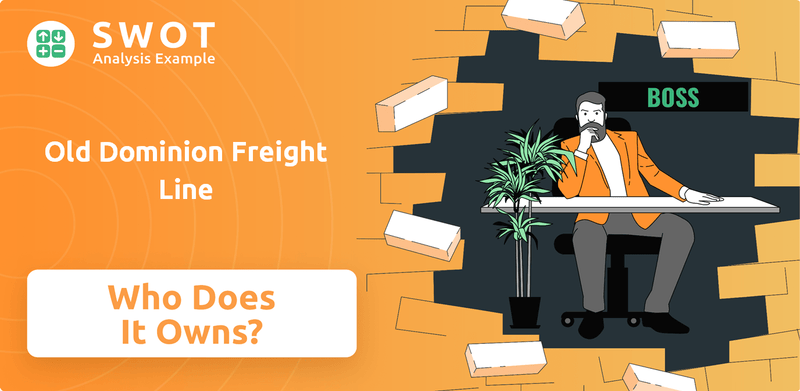
This exploration of Old Dominion ownership unveils the evolution of ODFL, from its family-run roots to its current status as a publicly traded entity. We'll examine the influence of major shareholders and the impact of its initial public offering. Discover the answers to questions like "Who is the CEO of Old Dominion Freight Line?" and "Is Old Dominion Freight Line a public company?" to gain a comprehensive view of this industry leader and its financial information.
Who Founded Old Dominion Freight Line?
Old Dominion Freight Line, a prominent freight company, began its journey in 1934. The company was founded by Earl Congdon Sr. and his wife, Lillian Congdon. Their initial investment and dedication laid the groundwork for what would become a major player in the transportation industry.
The early days of Old Dominion Freight Line saw the Congdons working closely together. Earl Sr. primarily drove the truck, while Lillian assisted in operations. This hands-on approach was typical of the company's humble beginnings, reflecting a strong family commitment.
Lillian Congdon's financial contribution of $1,700, saved from her job as a telephone operator, was crucial in acquiring the first truck. By 1942, the Congdons were equal partners, solidifying their roles in the business. This early partnership structure was a key element in the company's initial growth and development.
Initially, Old Dominion Freight Line operated with a single truck. The Congdons managed all aspects of the business from their home.
By 1942, Earl Sr. and Lillian Congdon formalized their partnership, each holding a 50% stake. This was a pivotal moment in the company's evolution.
Lillian Congdon's savings of $1,700 were used to purchase the first truck. This financial backing was crucial for the company's launch.
By 1944, the company had expanded to 14 straight trucks, 18 tractors, and 25 trailers. The workforce grew to 74 employees.
After Earl Congdon Sr.'s passing in 1950, Lillian Congdon became president. Their sons, Earl Jr. and Jack, also took on leadership roles.
The company was incorporated following Earl Sr.'s death. In 1935, it received an operating certificate from the ICC, giving it a competitive edge.
The founders' commitment to customer service remains a core value, shaping the company's culture and strategy. The early focus on customer promises has been a guiding principle for the company. The family's involvement and leadership were critical to the long-term success of Old Dominion Freight Line. Understanding the history of Old Dominion ownership provides valuable insights into the company's values and operational strategies.
- Old Dominion Freight Line was founded in 1934 by Earl Congdon Sr. and Lillian Congdon.
- Lillian Congdon's initial investment of $1,700 was crucial for the company's start.
- By 1942, the Congdons were equal partners.
- After Earl Sr.'s death, Lillian Congdon became president, and their sons joined the leadership.
Old Dominion Freight Line SWOT Analysis
- Complete SWOT Breakdown
- Fully Customizable
- Editable in Excel & Word
- Professional Formatting
- Investor-Ready Format
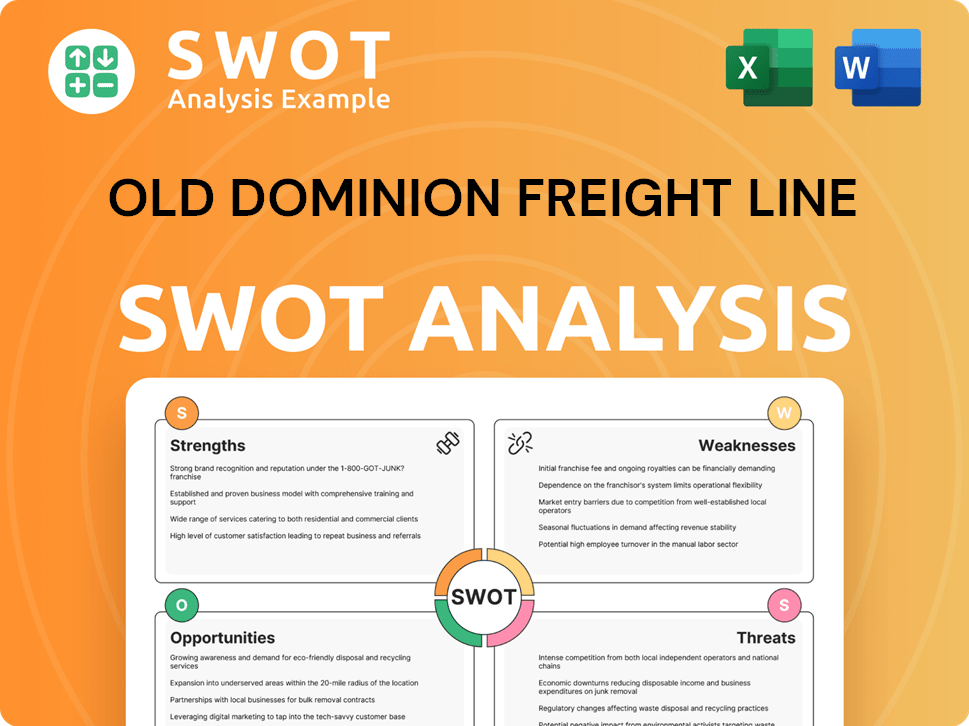
How Has Old Dominion Freight Line’s Ownership Changed Over Time?
The evolution of Old Dominion Freight Line's Old Dominion ownership structure is a key part of its story. The company transitioned to a public entity in 1991 via an Initial Public Offering (IPO), which listed on the NASDAQ under the ticker symbol ODFL. This step was crucial, providing the necessary capital for expansion, network growth, and technological advancements. This move was a pivotal change for the freight company, allowing it to scale its operations and increase its market presence.
As of late 2024 and early 2025, ODFL is a publicly traded company. Its shares are held by a diverse group, including institutional investors, company insiders, and the general public. This structure reflects the company's growth and its integration into the broader financial markets. The shift to public ownership has been instrumental in enabling Old Dominion to expand its operations significantly, growing to over 260 locations and more than 22,000 employees.
| Ownership Category | Percentage of Ownership (Approximate) | Notes (As of Early 2025) |
|---|---|---|
| Institutional Investors | ~79% | Hold a significant majority of the stock; 12 investors hold a majority stake of 51%. |
| Insiders | ~9.71% | Includes key individuals like David S. Congdon, the largest individual shareholder. |
| Public and Individual Investors | ~10% | Represents the general public's investment in the company. |
Institutional investors are major players in Old Dominion ownership. As of May 6, 2025, institutions held 79% of the shares. According to March 2025 data, approximately 62.51% of the company's stock is held by Institutional Investors. Some of the major institutional shareholders include Vanguard Group Inc. (holding 10% of shares outstanding), BlackRock, Inc., and State Street Corp. Vanguard Group, Inc. is the largest shareholder, with 23 million shares valued at $3.8 billion as of March 2025. BlackRock holds 17 million shares valued at $2.8 billion as of March 2025. Insiders also maintain a notable holding in ODFL, owning US$3.5 billion worth of shares, representing approximately 9.71% of the company's stock. David S. Congdon, the largest individual shareholder, owns 16.93 million shares, representing 8.01% of the company, valued at $2.75 billion. The general public holds about 10% ownership.
Understanding the ownership structure of Old Dominion Freight Line is crucial for investors. The company's stock, or ODFL stock, is primarily held by institutional investors, company insiders, and the public.
- Institutional investors hold a large portion of the shares.
- Insiders, including family members of the founders, have a significant stake.
- The public and individual investors also play a role in the Old Dominion ownership structure.
- For more insights, check out the Growth Strategy of Old Dominion Freight Line.
Old Dominion Freight Line PESTLE Analysis
- Covers All 6 PESTLE Categories
- No Research Needed – Save Hours of Work
- Built by Experts, Trusted by Consultants
- Instant Download, Ready to Use
- 100% Editable, Fully Customizable
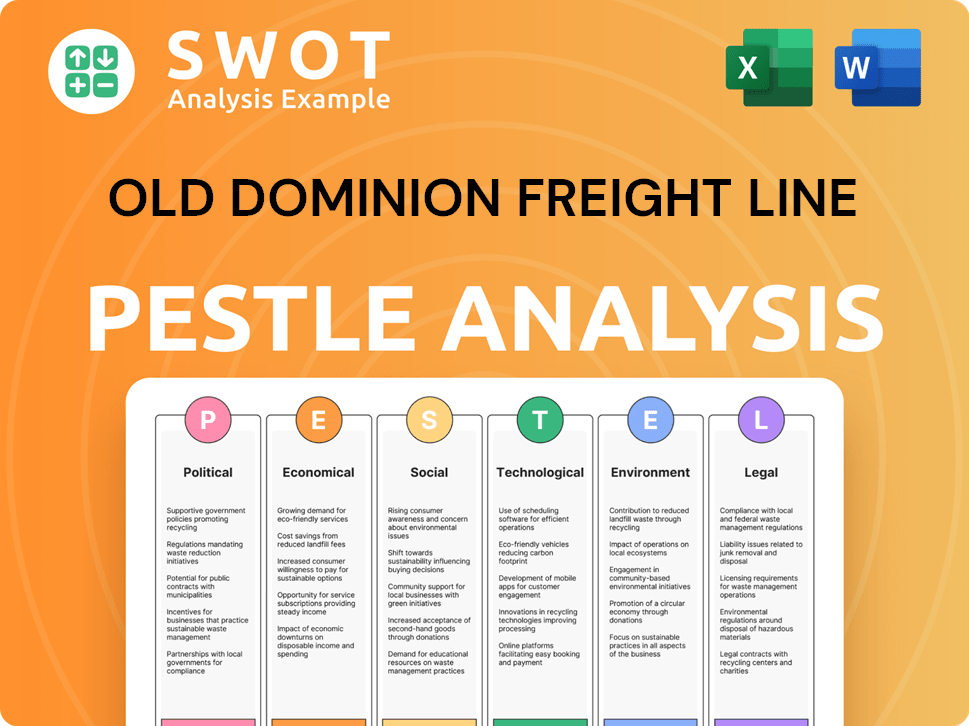
Who Sits on Old Dominion Freight Line’s Board?
The current board of directors of Old Dominion Freight Line plays a vital role in the company's governance. David S. Congdon, a descendant of the company's founders, holds the position of executive chairman. Kevin 'Marty' Freeman serves as President and CEO, with Gregory Plemmons as COO, and Adam Satterfield as CFO. Other board members include John R. Congdon Jr. and Cecil E. Overbey, Jr. The Annual Meeting of Shareholders was scheduled for May 21, 2025, to elect twelve directors to the Board for one-year terms.
The leadership team at Old Dominion Freight Line, including the executive chairman, CEO, COO, and CFO, steers the strategic direction of the freight company. This team, along with the other board members, oversees the company's operations and ensures alignment with shareholder interests. Understanding the composition of the board is crucial for anyone looking into Old Dominion ownership and its impact on the company's performance.
| Board Member | Title | Key Role |
|---|---|---|
| David S. Congdon | Executive Chairman | Oversees strategic direction |
| Kevin 'Marty' Freeman | President and CEO | Leads company operations |
| Gregory Plemmons | COO | Manages operational efficiency |
| Adam Satterfield | CFO | Handles financial matters |
The voting structure at Old Dominion Freight Line is based on a one-share-one-vote principle. Each share of common stock is entitled to one vote for each director nominee and each proposal. A quorum for conducting business at the Annual Meeting is established by the presence of a majority of the outstanding shares of Common Stock, either in person or by proxy. Proposals to amend the company's articles of incorporation require a vote in favor by more than two-thirds of the outstanding shares entitled to vote. Institutional investors hold a significant majority of the shares, but no single shareholder has outright control, with the top 12 investors collectively holding 51% of the company. Shareholders can exercise their voting rights on their common stock and receive proxy materials. If you're interested in learning more about the company's approach to its target market, you can read this article about the Target Market of Old Dominion Freight Line.
Shareholders of ODFL stock have the right to vote on key decisions.
- One-share-one-vote system.
- Majority of shares needed for a quorum.
- Special resolutions need a two-thirds majority.
- Institutional investors hold a significant portion of shares.
Old Dominion Freight Line Business Model Canvas
- Complete 9-Block Business Model Canvas
- Effortlessly Communicate Your Business Strategy
- Investor-Ready BMC Format
- 100% Editable and Customizable
- Clear and Structured Layout
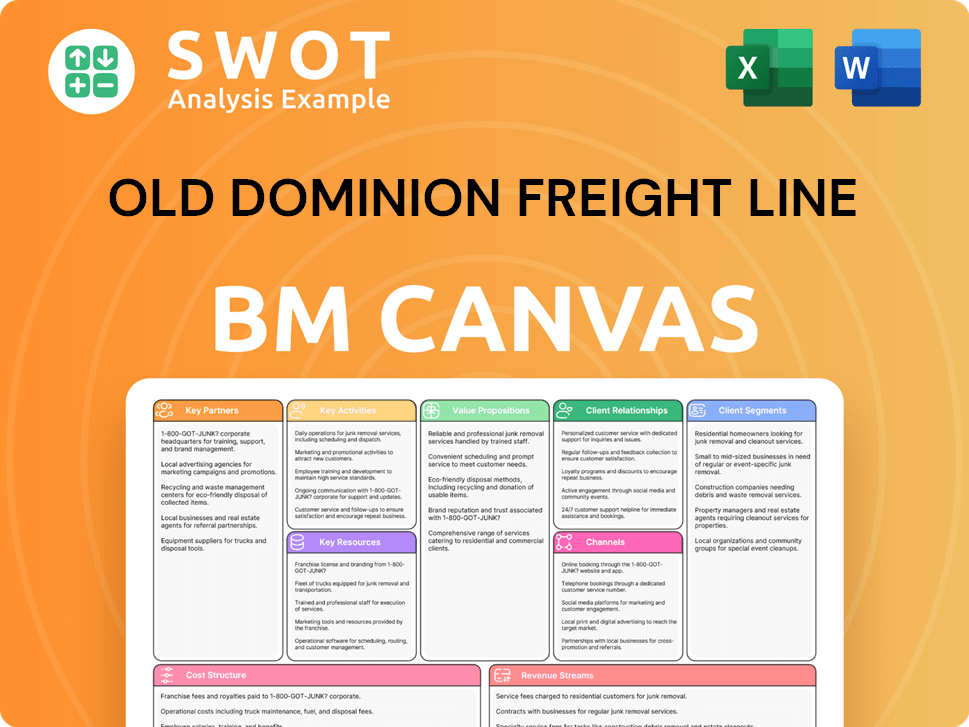
What Recent Changes Have Shaped Old Dominion Freight Line’s Ownership Landscape?
In recent years, Old Dominion Freight Line (ODFL) has consistently demonstrated a commitment to returning capital to its shareholders. The company has actively engaged in share buybacks and dividend payments, even amidst economic fluctuations. For instance, in 2024, ODFL allocated $967.3 million for share repurchases, including a $200 million accelerated share repurchase program, and distributed $223.6 million in cash dividends. This trend continued into the first quarter of 2025, with $201.1 million spent on share repurchases and $59.5 million in cash dividends. The Board of Directors also authorized a 7.7% increase in the quarterly cash dividend in the first quarter of 2025, setting it at $0.28 per share, payable on March 19, 2025.
Ownership trends for Old Dominion Freight Line show a stable institutional presence. As of May 2025, institutional investors held approximately 78.83% of the shares, indicating continued confidence in the freight company. Insider holdings saw a slight increase, moving from 0.56% to 0.58%. Key institutional holders such as Vanguard Group Inc. and BlackRock, Inc. maintain significant stakes in the company, reflecting the sustained interest from major investors in ODFL stock.
| Metric | 2024 | Q1 2025 |
|---|---|---|
| Share Repurchases (Millions) | $967.3 | $201.1 |
| Cash Dividends (Millions) | $223.6 | $59.5 |
| Institutional Ownership | 78.83% (May 2025) | - |
| Insider Ownership | 0.58% (May 2025) | - |
Old Dominion Freight Line has also strategically managed its capital expenditures. In 2024, capital expenditures totaled $771.3 million. The company initially planned approximately $575 million in capital expenditures for 2025, including investments in real estate, service center expansion, tractors, trailers, and information technology. However, ODFL adjusted its 2025 capital expenditure guidance to $450 million, representing a $125 million reduction from earlier plans, with a focus on real estate and IT investments. These decisions reflect the company's ongoing commitment to long-term growth and shareholder returns.
ODFL continues to invest in real estate and IT to support long-term growth, even amid economic challenges.
The company maintains a strong focus on returning capital to shareholders through dividends and share buybacks.
Institutional investors hold a significant stake, demonstrating confidence in the long-term prospects of the transportation company.
Strategic capital expenditure adjustments reflect ODFL's adaptability to market conditions.
Old Dominion Freight Line Porter's Five Forces Analysis
- Covers All 5 Competitive Forces in Detail
- Structured for Consultants, Students, and Founders
- 100% Editable in Microsoft Word & Excel
- Instant Digital Download – Use Immediately
- Compatible with Mac & PC – Fully Unlocked
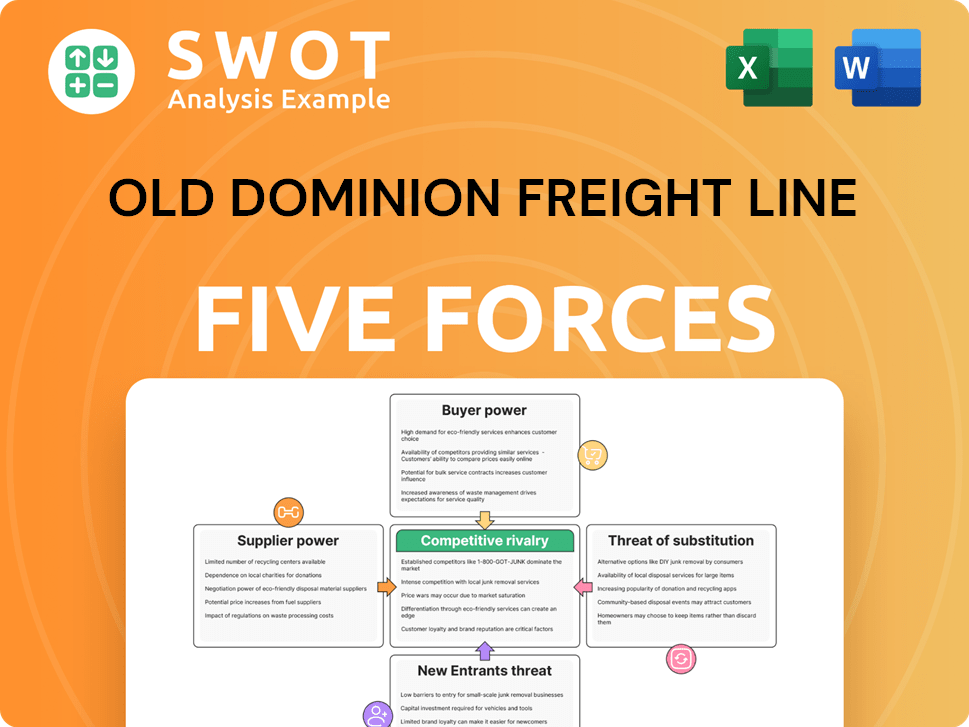
Related Blogs
- What are Mission Vision & Core Values of Old Dominion Freight Line Company?
- What is Competitive Landscape of Old Dominion Freight Line Company?
- What is Growth Strategy and Future Prospects of Old Dominion Freight Line Company?
- How Does Old Dominion Freight Line Company Work?
- What is Sales and Marketing Strategy of Old Dominion Freight Line Company?
- What is Brief History of Old Dominion Freight Line Company?
- What is Customer Demographics and Target Market of Old Dominion Freight Line Company?
Disclaimer
All information, articles, and product details provided on this website are for general informational and educational purposes only. We do not claim any ownership over, nor do we intend to infringe upon, any trademarks, copyrights, logos, brand names, or other intellectual property mentioned or depicted on this site. Such intellectual property remains the property of its respective owners, and any references here are made solely for identification or informational purposes, without implying any affiliation, endorsement, or partnership.
We make no representations or warranties, express or implied, regarding the accuracy, completeness, or suitability of any content or products presented. Nothing on this website should be construed as legal, tax, investment, financial, medical, or other professional advice. In addition, no part of this site—including articles or product references—constitutes a solicitation, recommendation, endorsement, advertisement, or offer to buy or sell any securities, franchises, or other financial instruments, particularly in jurisdictions where such activity would be unlawful.
All content is of a general nature and may not address the specific circumstances of any individual or entity. It is not a substitute for professional advice or services. Any actions you take based on the information provided here are strictly at your own risk. You accept full responsibility for any decisions or outcomes arising from your use of this website and agree to release us from any liability in connection with your use of, or reliance upon, the content or products found herein.